CELEBRATING A CENTURY OF DISCOVERY
Travel through 100 years of innovation, progress and pioneering research.
The launch of the Journal of Dental Research lays the foundation for the recording of monumental findings in the field of oral health.
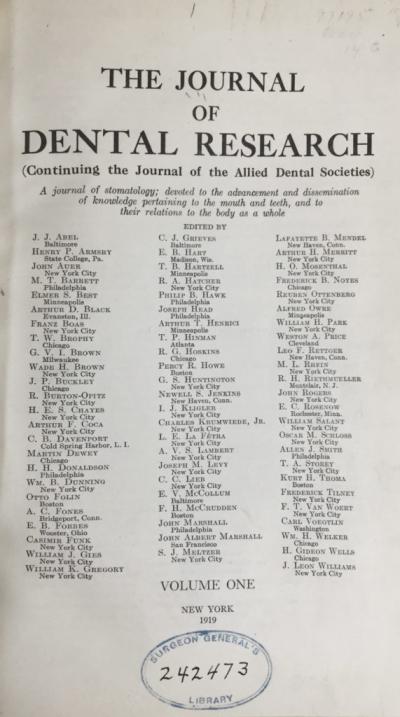
THE FOUNDATION OF THE JOURNAL OF DENTAL RESEARCH
The Journal of Dental Research was founded by William Gies in 1919, a year before he founded the IADR. Surprisingly, for several years the Journal and the Association functioned as very distinct entities. The Journal did not print any information about Association activities until 1926, although in 1921 there was an incidental footnote in the JDR that alluded to the existence of the Association.
It’s a series of firsts for the newly formed International Association for Dental Research — from new chapters and leaders to the inaugural general meeting — as well as for standards in the overall field of dental science.

THE FOUNDATION OF THE IADR
The IADR was founded in 1920 by William Gies, who believed that "such an association could be best formed as a federation of local societies, each to be in effect an autonomous section of a national division of the international organization." He contacted 100 of the leading dentists in New York City to begin forming the first chapter in what was then the largest city in the United States. The first dinner meeting took place on December 10, 1920, at the Columbia University Club, with the intent to "consider the advisability of promoting research by an international organization." At that meeting, a Chairman and Secretary were selected and the initial Articles of Agreement were adopted.

FIRST ANNUAL MEETING OF THE IADR
The first annual meeting of the IADR was held on December 21, 1922, at the Plaza Hotel in New York City. Although there were only four local sections in existence at this point, the meeting was well attended. However, it was still a bit meager in its scientific content - only two papers were presented, in contrast to the thousands that are presented at more recent General Sessions
ADA FORMS RESEARCH PARTNERSHIP WITH NBS TO DEVELOP STANDARDS FOR DENTAL MATERIALS
In 1929, the American Dental Association (ADA) established a cooperative research program with the National Bureau of Standards in order to develop standards, specifications and test methods for dental materials used by the U.S. War Department. Originally called the ADA Research Commission, the name was later changed to the Paffenbarger Research Center, and then recently renamed the ADA Foundation Volpe Research Center (VRC). Groundbreaking inventions that have emerged from this partnership include the panoramic X-ray machine, the high-speed handpiece, resin composite filling materials and dental bonding systems. The National Bureau of Standards is now known as the National Institute of Standards and Technology (NIST). Today, NIST and the VRC continue the tradition of performing groundbreaking dental materials research and transferring scientific advances from the bench to the clinic.
Researchers focus their attention on the role water and nutrition play in oral health, while toothbrush bristles get a makeover and IADR goes international.
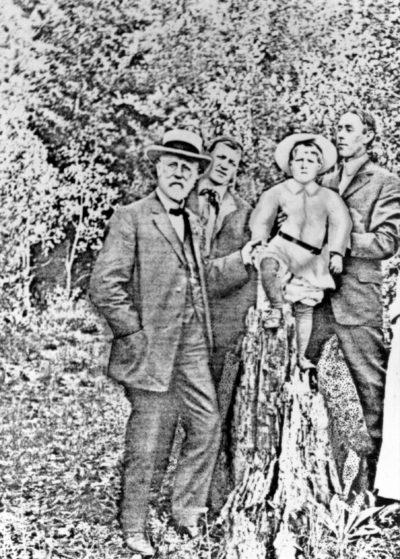
RESEARCH ON THE AETIOLOGY OF MOTTLED ENAMEL GAINS MOMENTUM
Frederick McKay publishes an overview of investigations to date, as the role of the water source has been inferred.
PHOTO CREDIT: Whelton inputs, The Present Status of the Investigation of the Cause, and of the Geographical Distribution, of Mottled Enamel, Including a Complete Bibliography on Mottled Enamel Frederick S. McKay, D.D.S. (JDR Volume: 10 issue: 5, page(s): 561-568)
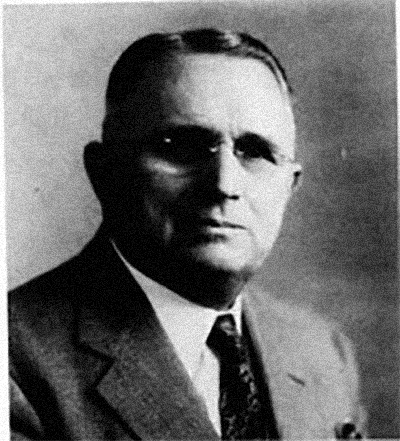
SOUDER CALLS FOR MORE DATA ON DENTAL MATERIALS
In a publication titled "Problems in Dental Research," Wilmer Souder seeks more research to establish the effectiveness of dental materials, calling for “data on the physical properties of materials and an attempt to show the application of these data to dental operations.”

THE NATIONAL INSTITUTE OF HEALTH IS ESTABLISHED
During World War I, the Public Health Service (PHS) and the staff of its Hygienic Laboratory attended primarily to sanitation of areas around military bases in the United States. In 1930, the Ransdell Act changed the name of the Hygienic Laboratory to National Institute of Health (NIH) and authorized the establishment of fellowships for research into basic biological and medical problems.
PHOTO CREDIT: National Institute of Health

EIGHTH ANNUAL MEETING OF THE IADR – FIRST OUTSIDE THE U.S.
The 8th Annual Meeting was held in Toronto, Ontario, Canada. It was noteworthy for being the first meeting outside the United States, which underscored the intention for the Association to be internationally focused. There were several attendees from overseas, some beginning to organize small sections such as the one from Vienna, Austria.

EPIDEMIOLOGICAL EVIDENCE FOR THE ROLE OF SUGAR STARTS TO INCREASE
E.V. McCollum and his associates made contributions in many areas of experimental nutrition. In 1922 they were the first to describe the gross appearance of dental caries in rats fed faulty diets. In 1931 Klein and McCollum showed that diets relatively high in phosphate are probably protective against dental caries. McCollum, however, always cautioned that the calcium-phosphorus ratio must be kept within a fairly limited range for health maintenance.

FLUORIDATION LEVELS FIRST LINKED TO MOTTLED ENAMEL
H. V. Churchill, a chemist with the Aluminum Research Laboratories, published a paper in the JDR on the association between fluoride in the water and enamel mottling, observing that, "It is of interest to note that apparently the relative severity of the defect in these various areas seems to follow the fluoride concentration."
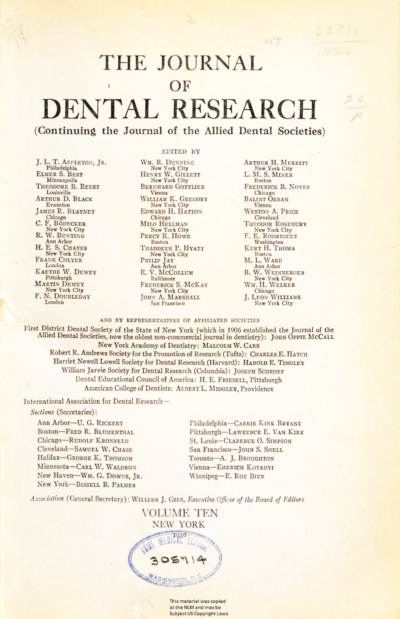
THE IADR TAKES OVER OWNERSHIP OF THE JDR
The Journal of Dental Research, founded in 1919 by William Gies, functioned independently from the IADR for its first 15 years. So independently, in fact, that in 1922, one page of the JDR displayed the IADR next to last in a list of its affiliated organizations (those that used the Journal pages as an outlet for their scientific proceedings). The IADR finally voted to take ownership of the Journal in 1934, with its Editor functioning as a major office-bearer in the Association.

STUDY FINDS LINK BETWEEN SUGAR AND DECALCIFICATION
A groundbreaking study shows that by incubation in media containing sugar or cereals mixed with saliva, healthy teeth were induced to decalcify after two to eight weeks.

INTRODUCTION OF THE VITALLIUM DENTAL SCREW IMPLANT
Alvin and Moses Strock experiment with a chromium-cobalt alloy known as Vitallium to restore individual teeth. However, due to lack of osseointegration their efforts were largely unsuccessful.
PHOTO CREDIT: Courtesy of pocketdentistry.com

SYNTHETIC NYLON TOOTHBRUSHES MAKE THEIR DEBUT
Boar bristles were typically used for toothbrushes until 1938, when nylon bristles were first introduced by DuPont de Nemours.

HA ZANDER REPORTS ON THE REACTION OF PULP TO CALCIUM HYDROXIDE
The action of Ca(OH)2 on the pulp tissue was reported and its potential in stimulating dentin bridge formation to protect the pulp was demonstrated.
IADR DENTAL MATERIALS GROUP ESTABLISHED
In 1939, after much correspondence and discussion between William Gies and colleagues, the Dental Materials Group was established as an affiliate of the IADR. It was “the first of a prospective series of groups within the Association to advance research in various aspects of dentistry.”

MCKAY AND DEAN LINK FLUORIDE TO MOTTLED ENAMEL AND DECREASED CARIES
Fluoride research began with the report of “mottled enamel” by Frederick McKay, found in his patients in Colorado Springs, USA. Henry Trendley Dean, a U.S. Public Health Service public-health dentist, collaborated with McKay in identifying “mottled enamel” or fluorosis as being associated with fluoride in the drinking water. Dean also discovered that there was an association between caries in children, mottled enamel and fluoride levels in the drinking water. He advocated that 1 ppm of fluoride be tested for its effects on caries.

GIES ELECTED IADR PRESIDENT
Although William Gies founded the IADR in 1920, it was not until 19 years later that he was elected IADR president.
PHOTO CREDIT: Portrait of William Gies by Peter R. Nelsen
In a decade of major dental advancements, fluoride makes its debut in drinking water, the precursor to dental sealants is developed and a U.S. president signs a dental research act into law.

COMMUNITY WATER FLUORIDATION BEGINS
On January 25, 1945, Grand Rapids, Michigan, became the first community in the United States to fluoridate its drinking water to prevent tooth decay, beginning a clinical trial that established the efficacy and safety of fluoride to prevent dental caries. This was one of the most significant public health advances of the 20th century.

USA PRESIDENT HARRY S. TRUMAN FORMS NIDR
Harry S. Truman, the 33rd USA President, signed the National Dental Research Act into law on June 24, 1948. The dental research section of the National Institutes of Health was named the National Institute of Dental Research (NIDR) and has since been renamed the National Institute of Dental and Craniofacial Research. Henry Trendley Dean, a past president of the IADR, was installed as the first NIDR director.

ADVANCES IN BONDING RESIN AND COMPOSITE FILLINGS
In 1949 Swiss chemist Oskar Hagger developed a system of bonding acrylic resin to dentin. Michael Buonocore used this technology to develop the first white (composite) fillings and the acid-etch technique for bonding resin to tooth enamel. These crucial developments eventually led to dental sealants, a major preventive measure effective against caries in children and adolescents and the basis of minimally invasive treatment of coronal caries today.
A series of milestones are achieved in the areas of materials and equipment, improving dental processes and the patient experience.
PROCTER & GAMBLE DEVELOP AND MARKET FIRST FLUORIDE TOOTHPASTE
Procter & Gamble subsidized a major research project at Indiana University, Bloomington, USA, exploring the use of stannous fluoride — a compound of fluoride and tin — in the prevention of tooth decay.
The research team produced a cavity-preventing toothpaste prototype by 1952 and proceeded to run clinical trials on 1,500 children and 400 adults in the area. After demonstrating that half of the participants showed a significant decrease in dental caries, Procter & Gamble released Crest toothpaste in 1956.
NORTH AMERICAN DIVISION OF THE IADR IS FOUNDED
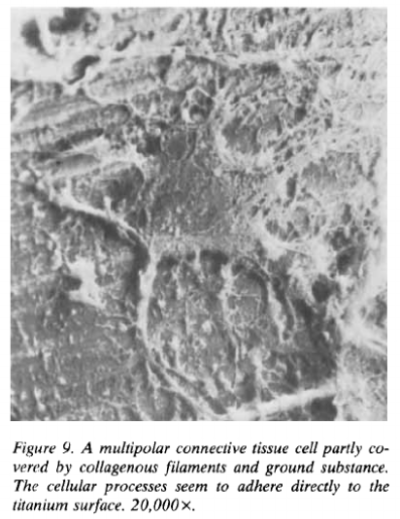
BRÅNEMARK OBSERVES OSSEOINTEGRATION OF TITANIUM IMPLANTS
The genesis of osseointegration as a concept was introduced by Per-Ingvar Brånemark, professor at the Institute of Applied Biotechnology, University of Gothenburg. He called it “a direct structural and functional connection between ordered living bone and the surface of the load-covering implant.”
PHOTO CREDIT: Albrektsson, T & Brånemark, P.I. & Hansson, Hans-Arne & JJ, Lindström. (1981). Osseointegrated Titanium Implants: Requirements for Ensuring a Long-Lasting, Direct Bone-to-Implant Anchorage in Man. Acta orthopaedica Scandinavica. 52. 155-70. 10.3109/17453678108991776.

BRITISH DIVISION OF THE IADR IS FOUNDED

JAPANESE DIVISION OF THE IADR IS FOUNDED

BUONOCORE EXPLORES THE ETCHING OF DENTAL ENAMEL
Known for his inquisitive nature, Michael Buonocore had a knack for exploring and evolving the dental research. While doing research at the Eastman Dental Center in Rochester, New York, USA, Buonocore experimented with adding a weak acid to the bonding process to increase the bond strength between the surface enamel and resin. The traditional acrylic resins were quickly replaced as Buonocore's discovery was better adept to handle the oral environment.

HIGH-SPEED AIR-DRIVE CONTRA-ANGLE HANDPIECE INTRODUCED
John Borden introduces a high-speed air-drive contra-angle handpiece. The Airotor obtains speeds up to 300,000 rotations per minute.
PHOTO CREDIT: Courtesy of the CP&S Historical Society, University of the Pacific, Dugoni School of Dentistry, dentalmuseum.pacific.edu.
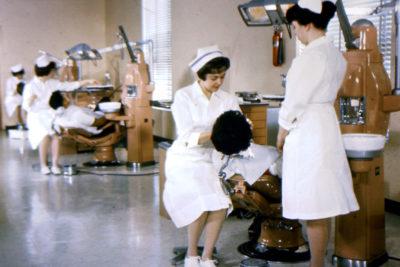
DEBUT OF THE FIRST FULLY RECLINING DENTAL CHAIR
The standard dental chair we've come to know today didn't begin mass production until 1958, when John Naughton redesigned the chair with the key break in the seat. This new design element allowed for a durable, yet flexible chair that was more comfortable for the patient yet didn’t obstruct the dentist’s access.
PHOTO CREDIT: Courtesy of the American Dental Hygienists’ Association
The use of dental crowns becomes more widespread. Gingivitis takes center stage.

PFM PORCELAINS DEVELOPED
To reduce the risk of internal microcracking during the cooling phase of fabrication, the porcelain-fused-to-metal (PFM) crown was developed in the late 1950s by Abraham Weinstein and implemented more widely in the early 1960s. The bond between the metal and porcelain prevented stress cracks from forming.
PHOTO CREDIT: Nizil Shah, Porcelain Fused to Metal Dental Crown Showing interior and exterior surfaces, CC BY-SA 4.0
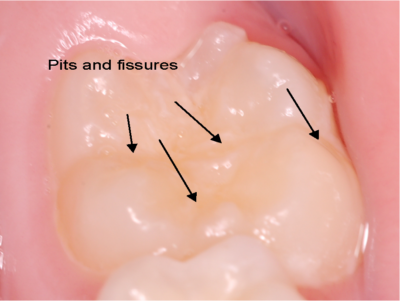
PIT-AND-FISSURE SEALANTS DEVELOPED
Thanks to Buonocore's reasearch on bonding acrylic resins and dental enamel, successors were able to further improve dental care.
In the 1960s, E.I. Cueto created the first pit-and-fissure sealant material intended for caries prevention. However, the sealant showed bacterial disintegration over time so it was never released on the public market. Over the next few years, with the help of Buonocore, a more successful sealant would be created and released to the public.
PHOTO CREDIT: Kristina Goršeta (March 11th 2015). Fissure Sealing in Occlusal Caries Prevention, Emerging Trends in Oral Health Sciences and Dentistry, Mandeep Singh Virdi, IntechOpen, DOI: 10.5772/59325. Available here.

TETRACYCLINE LINKED TO TEETH STAINING
Demonstration that systemic tetracycline stains teeth during development.

BIS-GMA BECOMES POPULAR FOR USE IN MODERN DENTAL COMPOSITES
Rafael L. Bowen, director of the American Dental Association Foundation Paffenbarger Research Center at National Bureau of Standards, invented a dental resin known as Bis-GMA used to bond composite restorations to dentin and enamel.
PHOTO CREDIT: By Politikaner – Self-photographed, Public Domain

THE IADR/AADR ENDORSE COMMUNITY WATER FLUORIDATION
Based on extensive scientific data and in conjunction with the U.S. Public Health Service, both the IADR and the American Association for Dental Research (AADR) officially endorsed community water fluoridation in 1962 and urged its institution by all scientific communities.

GINGIVAL INDEX CREATED
The Gingival Index was created by Löe and Silness in 1963 for the assessment of the gingival condition and recording of qualitative changes in the gingiva. It scores the marginal and interproximal tissues separately on a scale of zero to three.
PHOTO CREDIT: CC Attribution-ShareAlike License

FIRST COMPOSITE FORMULATIONS BASED ON BOWEN FORMULA
Rafael Bowen documented chemical treatment of silica particles so their surfaces could be intimately bonded into a mixture with polymer during curing and generate a strong restorative material. The coating material used was tris(2-methoxyethoxy) vinyl silane.

THE IADR ELECTS FIRST NON-NORTH AMERICAN PRESIDENT
Martin A. Rushton, a professor at the University of London, England was formerly the president of the British Division of the IADR.

CONTINENTAL EUROPEAN DIVISION IS FOUNDED
CENTRAL IADR OFFICE ESTABLISHED
An IADR Central Office was established in 1965 on the 16th floor of the ADA Building in Chicago, Illinois, USA.
It included a full staff and the appointment of Arthur R. Frechette as the only full-time salaried Secretary-Treasurer in the history of the Association.

LÖE STUDIES EXPERIMENTAL GINGIVITIS IN HUMANS
After 9-21 days without oral hygiene, 11 experimental subjects with previously excellent oral hygiene and healthy gingivae developed heavy accumulations of plaque and generalized mild gingivitis.
CRANIOFACIAL BIOLOGY GROUP ESTABLISHED
AUSTRALIA AND NEW ZEALAND RECOGNIZED AS NON-DIVISIONAL SECTIONS

COLLAGENASE ACTIVITY DISCOVERED IN GINGIVA
Fullmer et al. demonstrated collagenase action through viscometry, acrylamide gel electrophoresis and electron microscopy.
Collagen was cleaved into one-quarter and three-quarter pieces by collagenase derived from human gingiva.

SOUTH AFRICAN DIVISION IS FOUNDED

ARGENTINE DIVISION IS FOUNDED

ISRAELI DIVISION IS FOUNDED

LINK CONFIRMED BETWEEN PLAQUE AND PERIODONTAL DISEASE
PHOTO CREDIT: Francisco B. Teixeira, Miki T. Saito, Filipe C. Matheus, Rui D. Prediger, Elizabeth S. Yamada, Cristiane S. F. Maia, Rafael R. Lima1, Periodontitis 01, CC BY 4.0

THE ORIGIN OF THE IADR LOGO
After two unsuccessful approaches to develop an acceptable emblem for the Association based on organizing competition within the field of art and design, the Committee took a new direction.
At the Forty-Sixth General Meeting of the IADR held in San Francisco, California, March 1968, the Committee decided to approach industrial firms in the fields of medical and dental illustration. ARRCO Medical Art and Design Company in Boston was engaged to prepare preliminary sketches of a revised emblem for consideration by the Committee.

THE IADR ELECTS FIRST AFRICAN-AMERICAN PRESIDENT
Clifton O. Dummett was a professor at the University of Southern California School of Dentistry, Los Angeles, USA.

SCANDINAVIAN DIVISION IS FOUNDED

MEXICAN DIVISION IS FOUNDED

AUSTRALIAN/NEW ZEALAND DIVISION IS FOUNDED
PERIODONTAL RESEARCH GROUP ESTABLISHED
The importance of the six-month dental examination is debunked. Sealants continue to improve.
EXPERIMENTAL PERIODONTITIS DEMONSTRATED IN A RAT MODEL
Sigmund Socransky’s research examines evidence that bacteria plays a role in the etiology of periodontal disease, observes the nature of the microorganisms that reside in the human gingival crevice region and discusses attempts to determine which of these organisms may be responsible for periodontal disease(s).

KLEINBERG EXAMINES THE BIOCHEMISTRY OF DENTAL PLAQUE
Israel Kleinberg’s extensive research dives into the chemical structure and metabolism of dental plaque, the mechanism of acquired pellicle and plaque formation, the effect of the acid-base metabolism of the plaque on the calcium phosphate exchange at the enamel-saliva interface, mineralization of dental plaque and more.
PHOTO CREDIT: Shaimaa Abdellatif, Plaque accumulation, CC BY-SA 4.0

GIBBONS AND COLLEAGUES EXAMINE BACTERIOCINS OF ORAL STREPTOCOCCI
In 1971, Ronald J. Gibbons and Johannes van Houte published a study that expanded the concept of adhesion and its effect on bacterial colonization of oral mucosal surfaces exposed to a fluid flow.
Gibbons followed it up with another paper, in conjuction with post-doctoral fellow Bill Liljemark, on the adhesion of additional oral genera. In 1972, along with Ray Williams, he published what was arguably his most well-known work on the subject, a study that identified prevention of specific bacterial adhesion as the major function of secretory IgA.

SOCRANSKY STUDIES RELATIONSHIP BETWEEN BACTERIA AND PERIODONTAL DISEASE
PHOTO CREDIT: Courtesy of the National Institute of Dental and Craniofacial Research (NIDCR), NIH

LÖE MAKES ADVANCES IN THE PREVENTION OF PLAQUE AND GINGIVITIS
In this study, 24 male dental students with healthy gingivae and clean teeth ceased all oral hygiene procedures and instead followed various chlorhexidine rinse patterns.
PHOTO CREDIT: Source

IMMUNIZATION OF MONKEYS WITH STREPTOCOCCUS MUTANS: SPECIFICITY OF ANTIBODY RESPONSES IN SALIVA
F.G. Emmings, R.T. Evans and Robert J. Genco conducted research showing that immunization of monkeys with S mutant strain 6715 via the parotid duct elicited a reproducible IgA antibody response in the parotid fluid as well as a serum antibody response.
Inhibition of colonization on tooth surfaces in immune monkeys showed specificity for the immunizing strain, suggesting that inhibition was antibody mediated.

PURIFICATION AND PROPERTIES OF AN ALPHA-(1 >3) GLUCANOHYDROLASE FROM TRICHODERMA HARZIANUM
B. Guggenheim and Rosemarie Haller research and describe the purification and properties of a-alpha-(1-3) glucanohydrolase enzyme with activity to ward insoluble glucans of streptococcal origin.
A major protein band stained with amido schwartz contained the enzyme activity, as revealed by the complete local hydrolysis of mutant agar containing this polysaccharide.

URIST AND STRATES STUDY BONE MORPHOGENETIC PROTEIN
Marshall R. Urist and Basil S. Strates conducted a study to research the molecular and biochemical characteristics of the bone morphogenetic protein.
BEHAVIORAL, EPIDEMIOLOGIC AND HEALTH SERVICES RESEARCH GROUP ESTABLISHED

LOESCHE STUDIES MEDIA USED TO TRANSPORT ORAL BACTERIA
Walter J. Loesche, a future IADR president, studied dental plaque samples collected using three types of transport media: a dithiothreitol poised balanced mineral salt solution designated as reduced transport fluid (RTF), VMG II and modified Stuart medium.
The data showed a great variation in the recovery of the oral bacterial flora from the plaque samples and Loesche concluded that RTF is a satisfactory medium for the transport of oral bacteria present in the samples.
PHOTO CREDIT: Courtesy of American Society of Microbiology
AMERICAN DIVISION IS FOUNDED
PHARMACOLOGY, THERAPEUTICS AND TOXICOLOGY GROUP ESTABLISHED
SALIVARY RESEARCH GROUP ESTABLISHED

FREEZE-ETCHING REVEALS ULTRASTRUCTURE OF SELECTED BACTERIA ISOLATED FROM DENTAL PLAQUE
Hubert N. Newman and Alan H. Britton investigate the usefulness and possible applications of freeze-etching and examined the ultrastructure of several bacteria that represent some of the morphologic types present in plaque.
ANTIBIOTICS EVALUATED AS AGENTS FOR CARIES CONTROL
During a study in 1973 involving Sprague-Dawley rats, it was concluded that caries were successfully blocked by the administration of 1-ephenamine penicillin.
The study tested various administration schedules and found that the greatest protection came when the drug was fed continuously.
ELECTRON MICROSCOPY USED TO STUDY FORMATION OF DENTAL PLAQUE
Unilever study uses a scanning electron microscope to investigate the colonization of enamel surfaces in vivo and some of the factors influencing plaque formation during the initial 24 hours after cleaning.
NEWMAN STUDIES ORGANIC FILMS ON ENAMEL SURFACES
GREENSPAN AND COLLEAGUES EXAMINE HISTOPATHOLOGY OF SJÖGREN’S SYNDROME
John S. Greenspan and his colleagues histologically examined labial salivary gland biopsy specimens from 75 patients for Sjögren's syndrome and discussed observations in the light of possible mechanisms of tissue damage in the disease.
MICROBIOLOGY AND IMMUNOLOGY GROUP ESTABLISHED
MINERALIZED TISSUE GROUP ESTABLISHED
PROSTHODONTICS GROUP ESTABLISHED
PULP BIOLOGY AND REGENERATION GROUP ESTABLISHED
CARIOLOGY RESEARCH GROUP ESTABLISHED
NEUROSCIENCE GROUP ESTABLISHED

SHEIHAM FINDS NO EVIDENCE FOR SIX-MONTH DENTAL CHECKUPS
Aubrey Sheiham was one of the earliest proponents of EBD (Evidence-based Dentistry) and published innovative, pioneering and often controversial manuscripts.
One of his most reputable papers concerned the scientific basis behind the traditional six-month dental examination. He found no scientific evidence to support it.
PHOTO CREDIT: Courtesy of Erik Christensen, Dentist.1, CC BY-SA 3.0

DURET PIONEERS USE OF CAD/CAM SYSTEMS FOR DENTISTRY
Francois Duret and his colleagues first introduced the CAD/CAM system into dentistry for its assistance with restorative processes.
In the late 1970s they released the commercial Sopha system, which ignited the enhancements in CAD/CAM systems in years to come.
PHOTO CREDIT: François Duret, francoisduret.com

MCCUNE EVALUATES EFFECTIVENESS OF PIT-AND-FISSURE SEALANTS
In an effort to prevent caries by way of pit-and-fissure sealants, RJ McCune conducted a study with 200 children, ages 6-8, living in South America.
The study tested the effectiveness of the sealants and after 36 months only 8 percent of treated teeth showed incidences of caries, as compared to 53 percent in untreated teeth.

CANADIAN DIVISION IS FOUNDED
ORAL AND MAXILLOFACIAL SURGERY GROUP ESTABLISHED
Innovation continues with the introduction of intraoral scanning technology.
INTRAORAL SCANNING TECHNIQUES FOR CAD/CAM
The CEREC (Chairside Economical Restoration of Esthetic Ceramics) was the first dental chairside CAD/CAM system, leading the way to the intraoral scanning techniques.
The new technology, integrated with the field of prosthodontics, allowed dentists to have digital impressions of patients, which increased the quality of dental prosthesis fabrications.
ORAL MEDICINE AND PATHOLOGY GROUP ESTABLISHED

THE IADR ELECTS FIRST FEMALE PRESIDENT
Born in Denmark on April 13, 1924, Marie U. Nylen was elected the 58th president of the IADR, making her the first woman elected president.

KOREAN DIVISION IS FOUNDED
IMPLANTOLOGY GROUP ESTABLISHED

IRISH DIVISION OF THE IADR IS FOUNDED
Group of Members at Inaugural Meeting in November 1984.

FIRST 3-STEP ETCH AND RINSE DENTIN ETCHING TECHNIQUE DEVELOPED
The introduction of the three-step, total-etch adhesive system represented a revolution in adhesive dentistry.
Once dentin was etched with phosphoric acid and the etchant was rinsed off, hydrophilic primers were used before applying a uniform layer of hydrophobic resin to complete hybridization.
PHOTO CREDIT: Courtesy of National Library of Medicine

EGYPTIAN SECTION IS FOUNDED
SOUTHEAST ASIAN DIVISION IS FOUNDED

CHILEAN DIVISION IS FOUNDED

EAST & SOUTHERN AFRICA DIVISION IS FOUNDED
GERIATRIC ORAL RESEARCH GROUP ESTABLISHED
DIAGNOSTIC SCIENCES GROUP ESTABLISHED
Lighting innovations and computerized medical records make their way into the dental world, while restorative care and dental research also see advancements.

LED CURING BECOMES MORE COMMON
Although visible LEDs were invented years before, it wasn’t until the 1990s that scientists and manufacturers seriously considered them as a light source in light curing units.
Their use became even more prevalent in 1994, when high-brightness blue-light-emitting GaN LEDs were invented.

DIGITAL PATIENT RECORDS INCREASE EFFICIENCY AND ACCURACY
Nearing the end of the 20th century, as electronics were beginning their boom, the development of electronic health records arose.
Due to the availability of more affordable, powerful and compact hardware and with the internet providing faster and easier access, the medical community adopted the practice of housing patient medical information electronically. For the majority of practices, digital records were introduced to increase efficiency and accuracy.

USE OF DIGITAL RADIOGRAPHY INCREASES
As with digital patient records, access to computers allowed for widespread acceptance of the advancements in radiography.
Unlike conventional radiography, digital radiography allows for post-processing adjustments in contrast, which expand the information that can be captured via film. In addition, film is coupled with high-cost, high-labor, hazardous materials and physical storage concerns.

DEVELOPMENTS IN RESIN MODIFIED GLASS-IONOMER CEMENTS
A.D. Wilson observes and discusses the recently developed dual-setting resin glass-ionomer cements and compares their chemistry and properties with those of conventional glass-ionomer cements, concluding that they may not be as biocompatible as conventional glass-ionomer cements.

FLOWABLE AND PACKABLE COMPOSITES DEVELOPED
Early composites were quartz-filled with large filler particles.
This format made restorations difficult and hard to polish. Flowable composites have a reduced filler load, making it flexible and more suitable to fill hard-to-reach areas, whereas packable composites were designed to achieve a better proximal contact and address issues such as shrinkage, wear and handling.
PHOTO CREDIT: Shaimaa Abdellatif [CC BY-SA 4.0], via Wikimedia Commons
FIRST ULTRASONIC TOOTHBRUSH PATENTED IN THE U.S.
The first ultrasonic toothbrush, initially branded Ultima and later Ultrasonex by Sonex Corporation, was patented in the United States in 1992 by Robert T. Bock. That same year, the FDA gave approval for daily home use.
Initially, the Ultima worked only on ultrasound. A few years later, a motor was added to the Ultrasonex brush, which provided additional sonic vibration.

VENEZUELAN DIVISION IS FOUNDED

SAUDI ARABIAN DIVISION IS FOUNDED
NUTRITION RESEARCH GROUP ESTABLISHED

PERUVIAN DIVISION IS FOUNDED

ZIRCONIA USE ADVANCES AND CAD/CAM SYSTEMS DEBUT
Ceramic restorations drastically changed in the mid-1990s, with the utilization of transformation-toughened zirconia, followed by the introduction of CAD/CAM systems.
PHOTO CREDIT: CC BY-SA 3.0, Source

BRAZILIAN DIVISION IS FOUNDED
ORAL HEALTH RESEARCH GROUP ESTABLISHED

FRENCKEN PRESENTS ATRAUMATIC RESTORATIVE TREATMENT MODEL
Jo E. Frencken shares a 15-step treatment module to help treat dental caries.
The atraumatic restorative treatment utilizes hand instruments and adhesive filling material to remove recalcified tooth tissue and restore the cavity. As this technique doesn't use electricity, it makes restorative oral care more accessible, specifically in underdeveloped countries.
PHOTO CREDIT: Atraumatic restorative treatment and minimal intervention dentistry

THE IADR OPENS NEW HEADQUARTERS IN ALEXANDRIA, VA
On the 75th Anniversary of the founding of the IADR, Association members from around the world gathered in Alexandria, Virginia, USA, to celebrate the official opening of the new IADR/AADR Headquarters Building.
EDUCATION RESEARCH GROUP ESTABLISHED

RUSSIAN SECTION IS FOUNDED
NIDR IS RENAMED NIDCR (NATIONAL INSTITUTE OF DENTAL AND CRANIOFACIAL RESEARCH)
On October 21, 1998, the NIDR officially changed its name to National Institute of Dental and Craniofacial Research to better represent its research focus and mission to improve dental, oral and craniofacial health.

CHINESE DIVISION IS FOUNDED
The United States Surgeon General emphasizes the importance of oral care to overall health. Metal braces of yesteryear get a plasticized makeover.
DENTAL ANESTHESIOLOGY RESEARCH GROUP ESTABLISHED

RESEARCH PROVES HEALTH CONNECTION OF BODY AND MOUTH
The United States Surgeon General's report in 2000 changed the way the public viewed their dental care by posing the connection that oral health went beyond just healthy teeth.
Oral health refers to the entire mouth; this includes the teeth and gums, but also the jaw, throat, mouth muscles and supporting tissue. The report goes on to purport that maintaining proper oral health is essential for general health and can be a successful component in disease prevention.

AMALGAM SEPARATORS BECOME STANDARD FOR DENTISTRY
Amalgam fillings have been utilized in dentistry for over 150 years, and have been proven to be safe while in a solid state in the mouth.
However, when an amalgam filling is removed, the mercury in the amalgam becomes “active” and toxic. In the early 2000s, dentists started using amalgam separators in their drain systems. The separator captures the waste material, which is then safely recycled.
PHOTO CREDIT: Courtesy of NovemberElla at Slovenian Wikipedia, Amalgam separator, CC BY-SA 3.0
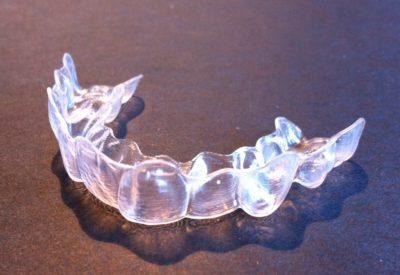
INVISALIGN ORTHODONTIC TREATMENT DEVELOPED
The founders of Invisalign, Align Technology, went public in 2001 with a new teeth-straightening alternative to the traditional metal braces system.
At first orthodontists were skeptical of the effectiveness of the plastic trays. As consumer demand rose, more and more orthodontists adopted the new method, now making it an international practice implemented in more than six million patients.
PHOTO CREDIT: Courtesy of Smikey Io, Invisalign aligner, CC BY-SA 3.0

KUWAITI DIVISION IS FOUNDED
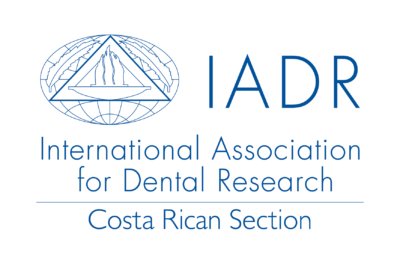
COSTA RICAN SECTION IS FOUNDED
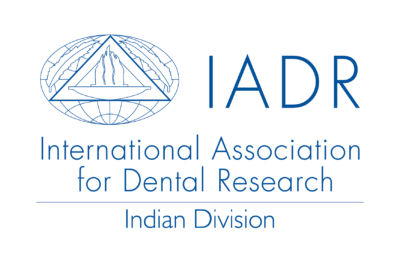
INDIAN SECTION FORMED
EVIDENCE-BASED DENTISTRY NETWORK ESTABLISHED

NIGERIAN DIVISION IS FOUNDED
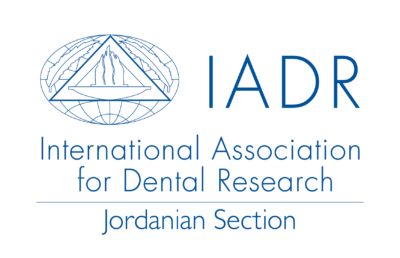
JORDANIAN SECTION IS FOUNDED

IRANIAN DIVISION IS FOUNDED

COLOMBIAN DIVISION IS FOUNDED

SUDANESE SECTION IS FOUNDED
PANAMANIAN SECTION IS FOUNDED
INTERNATIONAL NETWORK FOR OROFACIAL PAIN AND RELATED DISORDERS METHODOLOGY (INFORM) FORMED

MONGOLIAN SECTION IS FOUNDED

URUGUAYAN DIVISION IS FOUNDED

ECUADORIAN SECTION IS FOUNDED
NETWORK FOR PRACTICE-BASED RESEARCH FORMED

SYRIAN SECTION IS FOUNDED
Water once again comes into focus with a worldwide commitment to reduce mercury pollution. A century of dental research is celebrated.

PAKISTAN SECTION IS FOUNDED

PARAGUAYAN SECTION IS FOUNDED

IRAQI DIVISION IS FOUNDED
WOMEN IN SCIENCE NETWORK FORMED
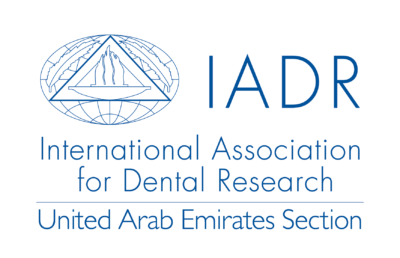
UNITED ARAB EMIRATES SECTION IS FOUNDED

LEBANESE SECTION IS FOUNDED

TUNISIAN SECTION IS FOUNDED
CLINICAL AND TRANSLATIONAL SCIENCE NETWORK FORMED
GLOBAL ORAL HEALTH INEQUALITIES RESEARCH NETWORK FORMED
PEDIATRIC ORAL HEALTH RESEARCH GROUP FORMED
MINAMATA CONVENTION ON MERCURY
The Minamata Convention on Mercury marked the beginning of a commitment to protect the health of the world’s population from mercury pollution and was a major breakthrough for the IADR, FDI, WHO and IDM.
STUDENT TRAINING AND RESEARCH (STAR) NETWORK FORMED
STEM CELL BIOLOGY GROUP FORMED

CARIBBEAN SECTION IS FOUNDED

LIBYAN SECTION IS FOUNDED

GUATEMALAN SECTION IS FOUNDED
JOCELYNE FEINE SELECTED AS INAUGURAL EDITOR FOR JDR CLINICAL & TRANSLATIONAL RESEARCH
E-ORAL HEALTH NETWORK FORMED
ORTHODONTICS RESEARCH GROUP FORMED
HOMAGE TO 100 YEARS OF DENTAL RESEARCH IN SCANDINAVIA
Nordisk Odontologisk Förening (NOF), the Scandinavian division of the IADR, held a special NOF Symposium in September 2017 in Vienna, Austria.
As a result, the supplement, “Homage to 100 Years of Dental Research in Scandinavia,” was published in the October 2017 issue of the European Journal of Oral Sciences.
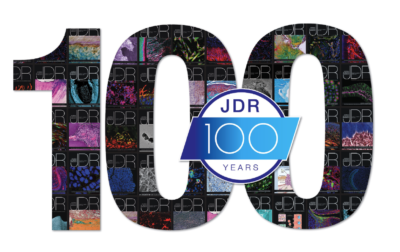
THE JDR CELEBRATES 100 YEARS
Over the last century, the JDR has been dedicated to the dissemination of new knowledge and information on all sciences relevant to dentistry and to the oral cavity and associated structures in health and disease.




